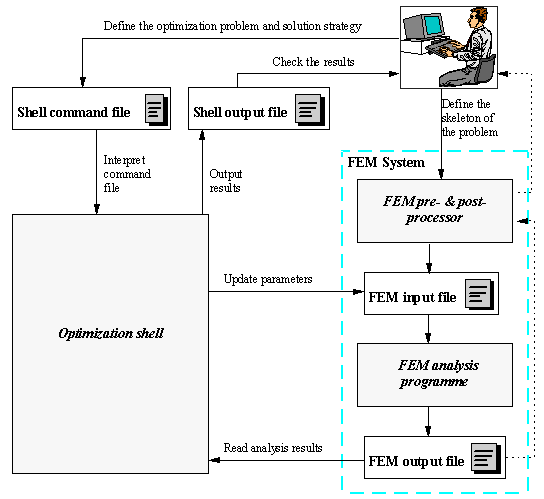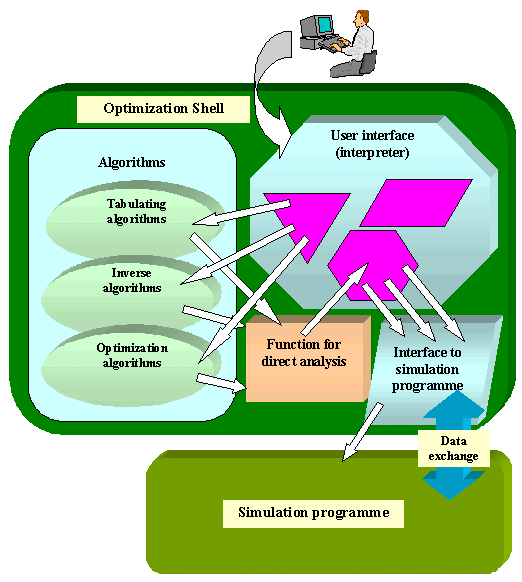
What Is INVERSE
The purpose of Inverse is to have a
programme
suitable for solving a wide range of optimization and inverse problems
in different environments. The programme should have a flexible
structure
and user interface so that it could be utilised for solving a great
variety
of problems. It should be easily connected with different simulation
programmes
and other external programmes specialised for solving individual
subproblems.
It should provide a basic scheme for definition of optimization
problems
and specification of the solution strategy. In this framework there
should
be a growing set of algorithms and tools, which could be employed in
problem
solution.
What is specific for Inverse
Inverse is a programming shell designed for
solving
optimization and inverse problems in connection with an analysis
programme.
The analysis programme must be capable of simulating the behaviour of
structures
or parts under operating conditions, the course of processes or
experiments,
etc., which are to be optimized. The shell and the analysis programme
together
form an optimization system such as shown in Figure 1. The FSQP
algorithm is used as the shell's basic optimization engine.
Main interaction points between user and the
system
are shell's command file and output file. User defines the problem and
its solution procedure by writing the command file which is interpreted
by shell's file interpreter. When the problem is being solved, the
shell
prints reports about its actions to its output file.
 |
(click
on image to enlarge it!)
Figure 1: Scheme of the optimization
system which
consists of the shell and a simulation programme. It is assumed that a
finite element method (FEM) based programme is used for simulation.
Basic
interactions between user and the system and between the parts of the
system
are shown.
|
User of the system typically defines a skeleton
of
the direct problems that are successively solved during the
optimization
process by the simulation programme. The optimization problem and the
solution
strategy are defined through the shell's command file. To ensure high
flexibility
at defining various problems, the command file syntax resembles a high
level programming language. All necessary supporting utilities like
optimization
algorithms, function definition facilities, mathematical tools
(function
approximation, matrix operations, etc.) and interfacing with the direct
simulation, are provided through the pre-defined shell interpreter
functions.
During the optimization procedure, simulations
are
successively run at different values of parameters (design parameters
in
the case of optimization or model parameters in the case of inverse
problems)
to evaluate values and derivatives of the objective functions and
constraints
and eventually some other necessary data. The exact way how an
individual
analysis is performed is also defined in the command file, in an
argument
block of the "analysis" function. Each time the optimization algorithm
(or some other supporting algorithm) requires evaluation of the
objective
function (or some other data bound by direct analysis), this block is
interpreted.
All functionality of the shell is available to the user for defining
the
way how the simulation is performed and how the connected data required
by optimization algorithms is evaluated. Typically function of the
interface
between the shell and the simulation programme are used for this
purpose,
as well as some data manipulation and mathematical functions.
Structure of the optimization system is shown in
Figure
2. Solution procedure is controlled by the command file interpreted by
shell's interpreter. Commands (or functions) in this file trigger
appropriate
actions associated with them. Command arguments determine exactly how
these
actions will be performed.
The most important functions are those associated
with built-in optimization and other algorithms. Common to these
algorithms
is that they require successive evaluation of objective functions and
other
data bound with the simulation at different values of parameters. This
is always performed by a special function which is built in the shell.
This function among the other triggers the interpretation of the
"analysis"
command argument block where user defines how the direct analysis is
performed.
This includes the way how input data for a simulation is set or updated
according to parameter values, how the simulation is performed and how
the data required by algorithms is evaluated using the simulation data.
 |
(click
on image to enlarge it!)
Figure 2: Structure of the
optimization system.
Invocation relations (white arrows) and data exchange between the shell
and the simulation programme (blue arrow) are shown.
|
Beside file interpreter's functions which perform
run algorithms and interface functions there are a lot of other
functions
which help the user to define the problem and its solution strategy.
These
functions enable the shell to interact with system environment, keep
results
of performed algorithms and use them as input data for other
algorithms,
perform various operations on the data, including basic mathematical
operations,
etc. All this is controlled through the interpretation of the command
file
written by user. Syntax of the command file enables not only sequential
execution of built-in tools, but also flow control. All the data which
at a given moment exists in the shell (i.e. was generated by shell's
actions)
can be used in loop and branching conditions or as arguments to
interpreter's
functions. This gives great flexibility to the system because there is
unlimited exchange of the data between different functional units of
the
shell.
Figure 3 is a simple presentation of the
main
data flows in the optimization system. Data exchange between the shell
and the simulation programme can be performed through the simulation
input
and output files, however this arrangement can be replaced by a direct
interface. In this case, the shell and the simulation programme are
typically
integrated in one programme and exchange date directly by accessing
each
other's memory (sketched by the two sided arrow in the figure). The
shell
incorporates a general file interface by which it can interface any
simulation
programme which can use text file input and output. Of course, direct
interface
is more convenient because it is faster and because what happens in the
simulation programme can be better controlled by the shell.
-
Flexible user interface implemented as a file interpreter
-
expression evaluator and file interpreter with
nested command
syntax enable flow control in a similar manner than do the high level
programming
languages.
-
high level commands enable simple use without
necessity for
flow control.
-
A collection of various optimization algorithms
-
The powerful FSQP
algorithm is the basic optimization engine of the shell.
-
Unconstrained minimization of non-linear functions
-
Constraint minimization: variable bounds, linear
and non-linear
inequality and equality constraints
-
A collection of auxiliary tools
-
A palette of tabulating utilities for examining
topology
of the objective functions
-
Monte Carlo simulations for examination of nature
of inverse
solutions
-
User defined variables for storing different types of data
-
Matrix, vector and scalar variables
-
Fields for storing discrete representations of
continuum
data (e.g. finite element meshes, scalar, vector & other fields)
-
Common operations on basic types of variables
-
Basic matrix and vector operations
-
Basic mathematical operations
-
Possibility of defining new operations
-
A general file interface for interfacing arbitrary simulation
programmes
through files
-
Built-in interfacing functions for data exchange between specific
simulation
programmes (presently applies only to Elfen)
-
Unlimited data transfer between different modules of the shell
-
All data is usable everywhere, results of one
operation are
accessible to following operations
-
Readily available reports about solution procedures
-
Output to terminal and to a file
-
All output except specially formatted data for
further
processing
-
Possibility of outputting virtually every
information that
exists in the shell
-
Different levels of use
-
Semi descriptive level
-
High level where some features of solution
algorithm are
controlled by the users
-
The highest level where also some basic
algorithms are programmed
by the user; in this case the shell can serve for providing a portion
of
algorithms, auxiliary utilities and utilities for interfacing system
environment
and simulation programme.
-
Openness
-
Easy adaptation for use with different simulation
programmes
-
Possibility of using external modules for partial
tasks (e.g.
for interfacing the simulation programme)
-
Syntax checker and Debugger
-
Syntax checker enables the user to discover
syntax errors
before running the projects which in many cases saves considerable
amount
of time.
-
Debugger facilitates location of tricky errors
which the
user makes at the construction of solution procedure. It enables
step-by-step
execution of the solution procedure. The user can on-line monitor
values
of all shell variables, assign different values to them and executes
additional
shell commands.



